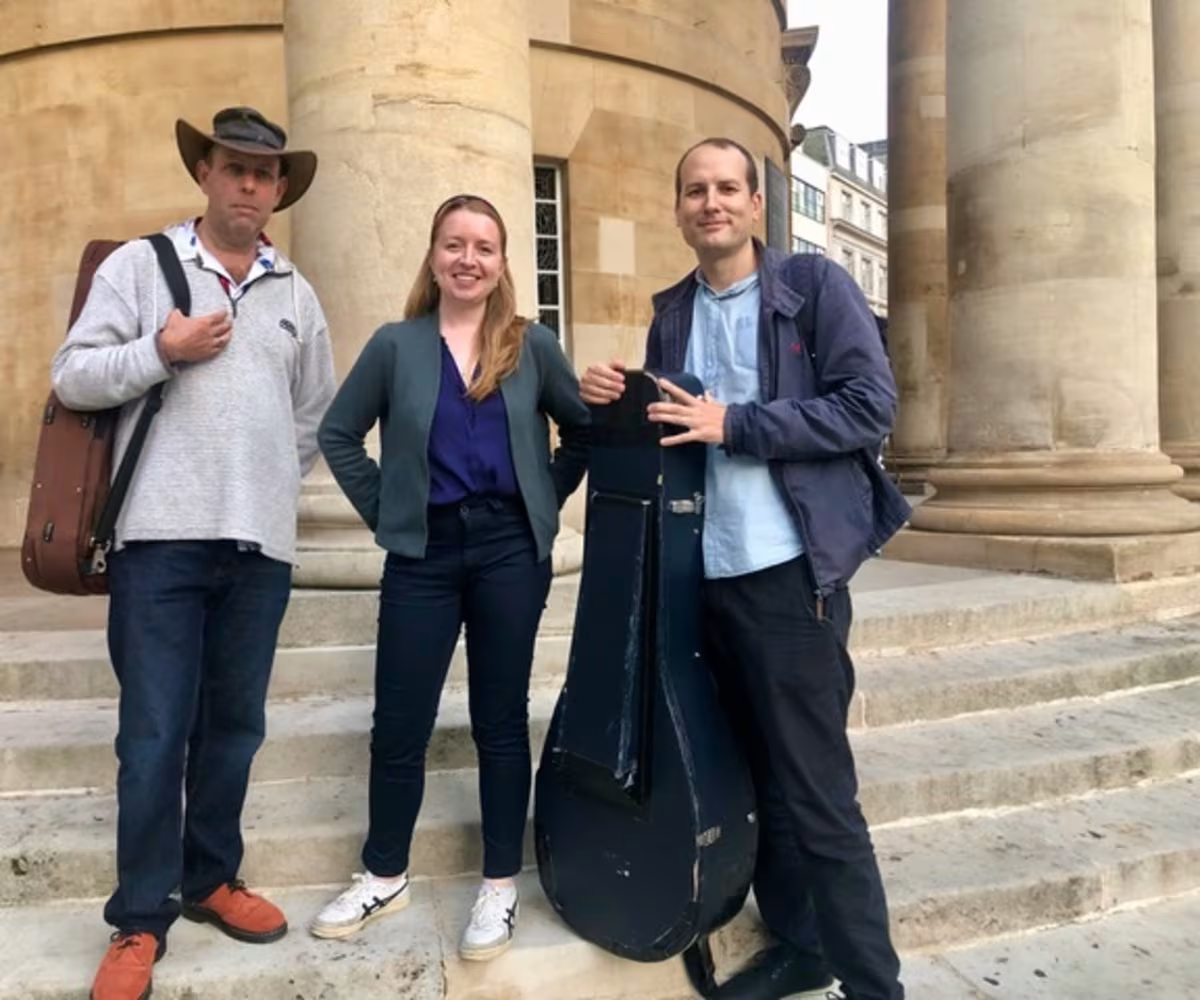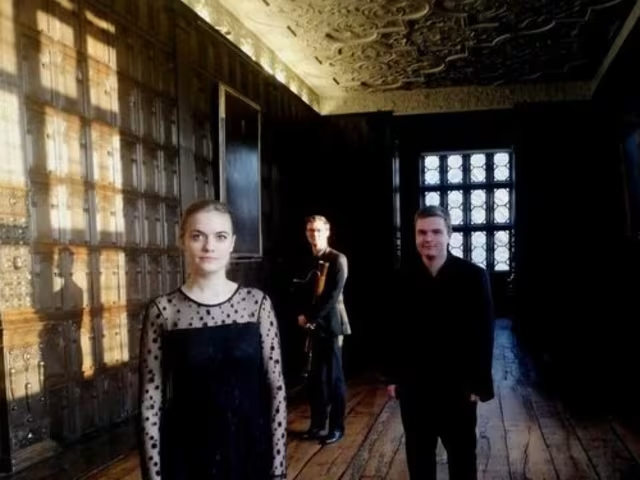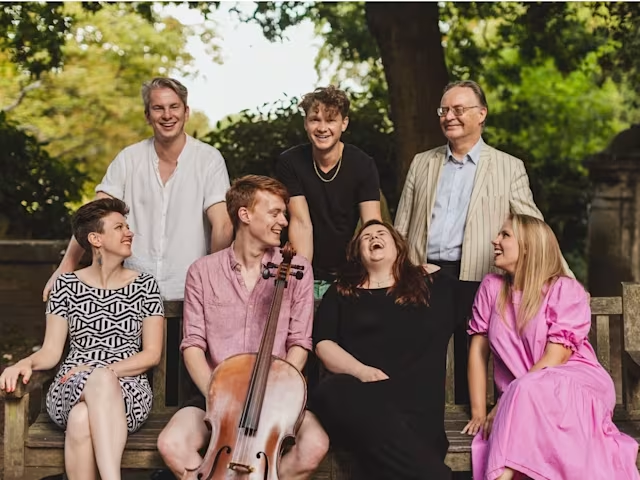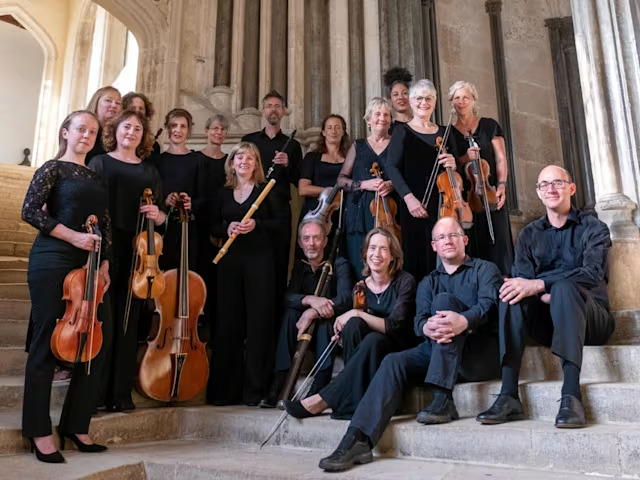Monteverdi String Band
A Thousand Flexible Ways
Dialogues From the Age of ‘Meraviglia’

We explore this territory with voice, violin, and lute. Inspired by the perennial advice for instrumentalists to model their playing on the execution of good singers, the violin takes the role of a second voice in several works, including Monteverdi’s iconic ciaccona ‘Zefiro torna’. The emerging instrumental styles are showcased in works by Marini and Kapsberger, and the solo voice runs the gamut of expressive styles, with Merula’s heart-rending lullaby to the infant Christ, painfully cognisant of his destiny, as one of the highlights.
Programme
Claudio Monteverdi (1567–1643): ‘Zefiro torna’
Luzzasco Luzzaschi (1545–1607): ‘Deh vieni ormai’
Giulio Caccini (1551–1618): ‘Queste lagrime amare’; Violin toccata + diminutions on ‘Vergine bella’
Claudio Monteverdi: ‘Ohimè ch’io cado’ with violin ritornelli
Biagio Marini (1594–1663): Sonata variata
Giacomo Carissimi (1605–1674): ‘Exulta, gaude, filia Sion’
INTERVAL
Giovanni Pierluigi da Palestrina (c. 1525–15): Vestiva i colli with diminutions for voice & violin
Giovanni Francesco Anerio (1569–1630): Galliard on 'Vestiva i colli'
Giovanni Felice Sances (1600–16): 'O Domine Jesu'
Giovanni Bassano (1561–1617): 'Ricercata Settima'
Thomas Crecquillon (c. 1505–1557): 'Par trop Souffrir' with diminutions for violin & lute
Johann Nauwach (1595–1630): 'Amarilli mia bella' passeggiata
Biagio Marini: Sonata
Tarquinio Merula (1595–1665): Canzonetta Spirituale; Ciaccona
Carlo G/Anon (dates unknown): 'Mater Ierusalem'
Tarquinio Merula: 'Cantate Jubilate'
The Monteverdi String Band
Oliver Webber violin
Hannah Ely soprano
Toby Carr lute, theorbo
 Worcestershire Early Music
Worcestershire Early Music Sun, 5 October 2025
Sun, 5 October 2025 The Old Palace, Worcester
The Old Palace, Worcester 3:30pm
3:30pm £22
£22
Full Event Details

The early decades of the Italian Seicento were astonishingly fruitful for the arts, and for music in particular: the emergence and refinement of Monteverdi’s ‘seconda pratica’ opened up a new realm of expressive possibilities, which composers were quick to take advantage of. The elegance and proportion of the previous century began to be coloured by a new zest for meraviglia (‘wonder, astonishment’), from which instrumentalists and singers alike benefited. One of the writers who attempted to capture these concepts was Emanuele Tesauro, whose Vocabolario (really more of a philosophical encyclopedia than a mere dictionary) includes an evocative description of a sweetly ornamenting voice, twisting and turning in ‘a thousand flexible ways’.
We explore this territory with voice, violin, and lute. Inspired by the perennial advice for instrumentalists to model their playing on the execution of good singers, the violin takes the role of a second voice in several works, including Monteverdi’s iconic ciaccona ‘Zefiro torna’. The emerging instrumental styles are showcased in works by Marini and Kapsberger, and the solo voice runs the gamut of expressive styles, with Merula’s heart-rending lullaby to the infant Christ, painfully cognisant of his destiny, as one of the highlights.
Programme
Claudio Monteverdi (1567–1643): ‘Zefiro torna’
Luzzasco Luzzaschi (1545–1607): ‘Deh vieni ormai’
Giulio Caccini (1551–1618): ‘Queste lagrime amare’; Violin toccata + diminutions on ‘Vergine bella’
Claudio Monteverdi: ‘Ohimè ch’io cado’ with violin ritornelli
Biagio Marini (1594–1663): Sonata variata
Giacomo Carissimi (1605–1674): ‘Exulta, gaude, filia Sion’
INTERVAL
Giovanni Pierluigi da Palestrina (c. 1525–15): Vestiva i colli with diminutions for voice & violin
Giovanni Francesco Anerio (1569–1630): Galliard on 'Vestiva i colli'
Giovanni Felice Sances (1600–16): 'O Domine Jesu'
Giovanni Bassano (1561–1617): 'Ricercata Settima'
Thomas Crecquillon (c. 1505–1557): 'Par trop Souffrir' with diminutions for violin & lute
Johann Nauwach (1595–1630): 'Amarilli mia bella' passeggiata
Biagio Marini: Sonata
Tarquinio Merula (1595–1665): Canzonetta Spirituale; Ciaccona
Carlo G/Anon (dates unknown): 'Mater Ierusalem'
Tarquinio Merula: 'Cantate Jubilate'
The Monteverdi String Band
Oliver Webber violin
Hannah Ely soprano
Toby Carr lute, theorbo
Venue Details & Map

Location
The Old Palace, Worcester
The Old Palace, Deansway, Worcester WR1 2JE
Related upcoming events

Voce Uguali: Equal Voices
Ensemble La Notte
 Sun, 11 January 2026
Sun, 11 January 2026 The Old Palace, Worcester
The Old Palace, Worcester 3:30pm
3:30pm £22
£22 Worcestershire Early Music
Worcestershire Early Music

Agrippina’s Betrayal
Players of The Hampstead Collective
 Sun, 1 March 2026
Sun, 1 March 2026 The Old Palace
The Old Palace 3:30pm
3:30pm £22
£22 Worcestershire Early Music
Worcestershire Early Music

JS Bach: Brandenburg Concerti Nos. 3-6
Musical & Amicable Society
 Sun, 19 April 2026
Sun, 19 April 2026 Henry Sandon Hall, Worcester
Henry Sandon Hall, Worcester 3:30pm
3:30pm £25 (free for under 18s)
£25 (free for under 18s) Worcestershire Early Music
Worcestershire Early Music
Previous performances
A Thousand Flexible Ways
 Sat, 10 May 2025
Sat, 10 May 2025 St Mary's Church, Kenardington
St Mary's Church, Kenardington 7:30pm
7:30pm £8 - £21
£8 - £21 Saxon Shore Early Music Kenardington
Saxon Shore Early Music Kenardington
A Thousand Flexible Ways
 Sat, 12 July 2025
Sat, 12 July 2025 St Cyr and St Julitta Church, Newton St Cyres, Devon
St Cyr and St Julitta Church, Newton St Cyres, Devon 6:30pm
6:30pm £15 - £30
£15 - £30 Music in Country Churches
Music in Country Churches
A Thousand Flexible Ways
 Sun, 12 October 2025
Sun, 12 October 2025 The Grand, Folkestone
The Grand, Folkestone 3:00pm
3:00pm £16
£16 Folkestone Early Music
Folkestone Early Music

